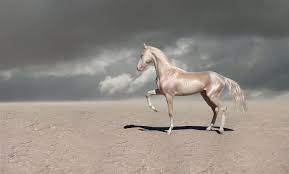
In a viral video circulating on social media, a rare and stunning horse breed known as Akhal-Teke is taking the spotlight. The breed is recognised for its breathtaking golden-silver hair, which glistens in the sunlight. Found predominantly in the Karakum Desert in Turkmenistan, the Akhal-Teke horses are gaining attention for their extraordinary beauty.
The video, shared by Gabriele Corno on Twitter, showcases the remarkable appearance of an Akhal-Teke horse, attracting viewers with its radiant coat. “This is a rare Akhal-Teke Turkmen horse breed. The shiny coat of the breed led to their nickname, Golden Horses,” mentions the caption accompanying the video.
The viral footage swiftly garnered attention, accumulating an impressive 82,000 views in a short span.
Originating from the Karakum desert in Turkmenistan, the Akhal-Teke breed is believed to have ancestral ties to Arabian horses. Despite their relatively modest height (1.6–1.65 m), these horses are characterized by their agility, gracefulness, silky hair with metallic reflections, and slender physique. Their notable attributes include exceptional speed, intelligence, and strength.
Reports indicate that the Akhal-Teke horses, known as Golden Horses, hold great value, with prices in India reaching up to Rs 30 lakh. Renowned for their loyalty, these horses reportedly permit only their owners to ride them. With fewer than 7,000 horses of this breed worldwide, the Akhal-Teke holds the status of the national animal of Turkmenistan.
Intriguingly, the breed faced two significant threats to its existence. Firstly, in 1924, violent earthquakes struck the city of Ashkabad, jeopardizing the Akhal-Teke horses. The second threat emerged in the 1950s when, due to human ignorance, the Russians contemplated turning these magnificent creatures into slaughter animals.
The Akhal-Teke horse, with its enchanting allure and limited global population, stands as a testament to the delicate balance between human interaction and the preservation of extraordinary species.
